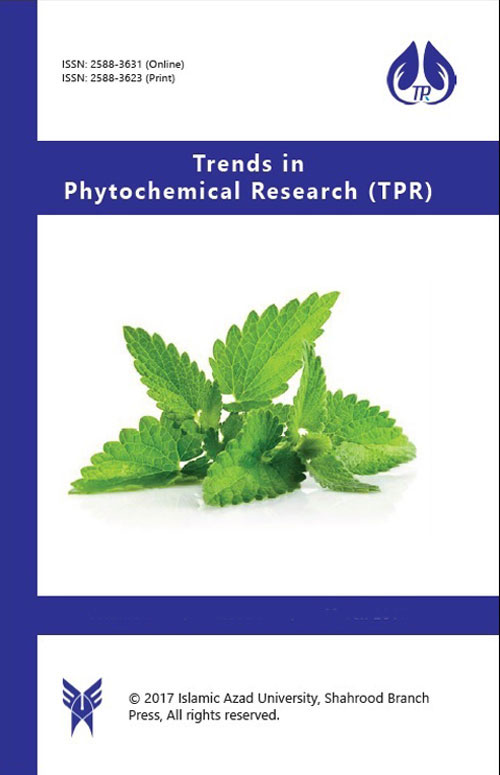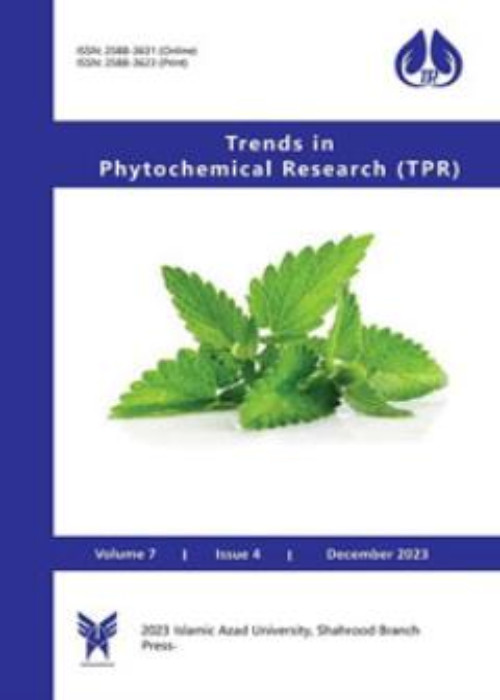فهرست مطالب

Trends in Phytochemical Research
Volume:4 Issue: 3, Summer 2020
- تاریخ انتشار: 1399/06/01
- تعداد عناوین: 6
-
Pages 101-108
Phyllanthus niruri Linn belongs to plant family Euphorbiaceae and is found in tropical and subtropical countries of the world including some regions of Sri Lanka and India. The extract of P. niruri Linn is the most commonly used medicine in Ayurveda system of medicine and has especially been recommended for the treatment of bronchitis, anaemia, skin diseases, asthma, cough, liver, kidney and urinary tract disorders. In the present study, an attempt was done to document the scientific investigations on phytochemicals and pharmacological activities of P. niruri Linn. According to the findings of P. niruri Linn, it shows potent pharmacological actions on hepatitis B virus, liver carcinoma, kidney stones and HIV. The available research suggested that P. niruri Linn has many beneficial health effects. However, human based data are sparse and conducting clinical trials will be necessary to prove more public health implications. These findings may be considered as clues to the development of novel pharmaceutical preparations from P. niruri Linn in future.
Keywords: Pharmacological activities, Phyllanthus niruri Linn, phytochemicals, Taxonomy, Therapeutic potential -
Pages 109-116
A new pyrrolidinyl-piperazine alkaloid derivative named 2-(7’-methylhexyloxy)furan-5’-yl)-6- (pyrrolidin-7-yl)piperazine (1), along with five known compounds were isolated from methanolic extract of the roots of Oxyanthus speciosus DC. (Rubiaceae). The structure of this new alkaloid was elucidated on the basis of the relevant NMR and MS analyses. Compound (1) possesses potent in vitro anti-inflammatory activity by protein denaturation assay with an IC50 value of 1.930 ± 0.9123 µg/mL. The obtained results indicated that the crude methanolic extract of O. speciosus DC. roots and its isolated pyrrolidinyl-piperazine alkaloid have potentials for further development as an effective and natural anti-inflammatory agents.
Keywords: Anti-inflammatory activity, Oxyanthus speciosus DC, Rubiaceae, 2-(7'-methylhexyloxy)-furan-5'-yl6-(pyrrolidin-7-yl)piperazine -
Pages 117-142
Cosmeceuticals are defined as cosmetic products designed to improve and enhance the physical appearance, beauty, health as well as to treat the skin ailments. The main objective of the present review is to document various plants along with their active phytochemicals like alkaloids, flavonoids, saponins, sterols, triterpenes, tannins, etc. responsible for activities like antioxidant, anti-inflammatory, sunlight protection, skin regeneration, de-pigmentation, anti-dandruff, anti-hair fall, anti-lice, etc. This study also provides an overview of geographical distribution, environmental attributes, extraction and isolation procedure of active phytochemicals responsible for biological activity. This review further tries to assess the regulatory scenario of cosmeceuticals as they are placed under the subclass of cosmetics under Europe and Japan regulations , whereas in US regulations, cosmeceuticals are placed under the subclass of drugs. The application of nanotechnology in formulating cosmeceuticals (nano-cosmeceuticals) has also seen the light of the day. It can be viewed as a “new paradigm” in the cosmetic industry.
Keywords: Cosmeceuticals, nanotechnology, Patents, Pharmacological uses, phytochemicals, phytotoxicity -
Pages 143-152Menthol rich with low menthofuran peppermint (Mentha piperita L.) genotype MPK-5 and their eight half-sib seed progenies were evaluated for different genetic parameters, namely coefficient of variation, genetic advance, heritability, associations, and path analysis for different economic characters, viz., plant height, leaf length, leaf width, leaf: stem ratio, herb yield, essential oil content (%), and contents of various essential oil constituents (quality traits) such as sabinene, myrcene, limonene, α-pinene, β-pinene, 1,8-cineole, menthone, menthofuran, neo-menthol, isomenthone, menthyl acetate, menthol, and pulegone. The phenotypic coefficient of variations (PCV) was found slightly higher than the genotypic coefficient of variations (GCV) for the characters studied, indicating that the apparent variation was not only due to genetic but also influenced by the growing environment for the expression of studied traits. The highest genotypic coefficients of variation (GCV) was noted for the character pulegone, followed by menthofuran and 1,8-cineole. High heritability coupled with high genetic advance was observed for menthol followed by pulegone demonstrating that these chemical compositions might be under non-additive genetic control. The genotypic correlations were higher than the phenotypic correlations for studied traits. The significant and positive associations of β-pinene with sabinene and 1,8-cineole; α-pinene with β-pinene, sabinene, and 1,8-cineole; menthyl acetate with neo-menthol; and sabinene with 1,8-cineole were noted. A high direct positive effect was also recorded between menthofuran and limonene.Keywords: Mentha piperita L, Genetic advance, Genetic improvement, Genotypic coefficient of variation, Phenotypic coefficient of variation, phenotypic correlation, selection
-
Pages 153-164Qurse pudina (QP), a poly herbal formulation which is used for treatment of constipation and gas problems in both Unani and Ayurvedic System of Indian Medicine. In the present article, an attempt has been made to standardize of the poly herbal formulation QP. The QP was standardized with the help of microscopic, physico-chemical and contamination evaluation. Study revealed that total bacterial and fungal count and Staphylococcus aureus were found under limit, while E. Coli was absent in the formulation. Pesticide residues, aflatoxin and toxic metals such as cadmium and mercury were not found in the formulation. Lead (0.75 mg/kg) and arsenic (0.50 mg/kg) were found under limit. The present outcome from contamination results suggest that QP is a good polyherbal formulation without showing any contamination or toxicity. The data evolved in the present work will aid in identifying the raw drugs used in finished product and will help to fix the scientific standards for QP.Keywords: Aflatoxins, Microbial load, Pesticide, Qurse pudina
-
Pages 165-176This study aims to evaluate the effects of season and spacing on growth patterns and seed yield performance of muskdana by estimating fixable and non-fixable components of genetic variances for diverse traits of economic significance and identification of highly divergent clusters of genotypes to exploit them in hybridization program. Radical scavenging activity of oil from muskdana seeds was also checked. The field experiment was conducted in two seasons , namely January to June (season I) and July to December (season II) with five spacing levels treatment 1, 2, 3, 4, and CIMAP of Abelmoschus moschatus. From the obtained results, it can be concluded that genotypes CIM-AM 22, CIM-AM 40, and CIM-AM 49 of A. moschatus showed greater potential in terms of yield. A. moschatus oil has also effective and powerful reducing power and exhibits significant radical scavenging activity which is comparable with standard antioxidants such as ascorbic acid, BHA, and BHT.Keywords: Cluster analysis, Genetic variability, Growth pattern, Radical scavenging activity, Seed yield


